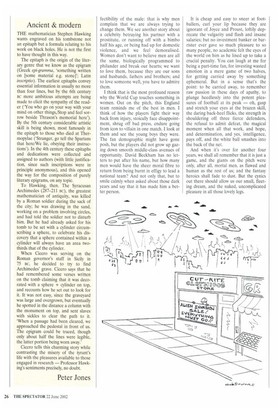Ancient & modern
THE mathematician Stephen Hawking wants engraved on his tombstone not an epitaph but a formula relating to his work on black holes. He is not the first to have thought in this way.
The epitaph is the origin of the literary genre that we know as the epigram (Greek epi-gramma, 'something written on [some material e.g. stone]'; Latin inscriptio). The earliest epitaphs convey essential information in usually no more than four lines, but by the 6th century BC more ambitious attempts are being made to elicit the sympathy of the reader (You who go on your way with your mind on other things,/Stop and feel sorrow beside Thrason's memorial here'). By the 5th century considerable artistic skill is being shown, most famously in the epitaph to those who died at Thermopylae (Stranger, go tell the Spartans that here/We lie, obeying their instructions'). In the 4th century these epitaphs and dedications were collected and assigned to authors (with little justification, since such inscriptions were in principle anonymous), and this opened the way for the composition of purely literary epigrams, on any topic.
To Hawking, then. The Syracusan Archimedes (287-211 BC), the greatest mathematician of antiquity, was killed by a Roman soldier during the sack of the city; he was drawing in the sand, working on a problem involving circles, and had told the soldier not to disturb him. But he had already asked for his tomb to be set with a cylinder circumscribing a sphere, to celebrate his discovery that a sphere contained within a cylinder will always have an area twothirds that of the cylinder.
When Cicero was serving on the Roman governor's staff in Sicily in 75 sc, he decided to try to find Archimedes' grave. Cicero says that he had remembered some verses written on the tomb claiming that it was decorated with a sphere + cylinder on top, and recounts how he set out to look for it. It was not easy, since the graveyard was large and overgrown, but eventually he spotted in the distance a column with the monument on top, and sent slaves with sickles to clear the path to it. 'When a passage had been cleared, we approached the pedestal in front of us. The epigram could be traced, though only about half the lines were legible, the latter portion being worn away.'
Cicero tells this charming story while contrasting the misery of the tyrant's life with the pleasures available to those engaged in research — Professor Hawking's sentiments precisely, no doubt.
Peter Jones










































































 Previous page
Previous page